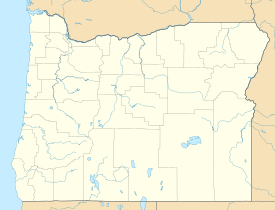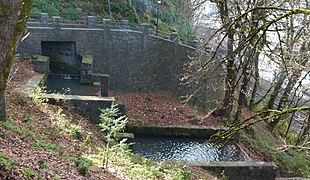McLoughlin Promenade
| McLoughlin Promenade | ||
|---|---|---|
| National Register of Historic Places | ||
|
McLoughlin Promenade |
||
|
|
||
| location | Oregon City , Oregon | |
| Coordinates | 45 ° 21 '17.5 " N , 122 ° 36' 36.8" W | |
| Built | 1936-1939 | |
| NRHP number | 14000179 | |
| The NRHP added | May 15, 2014 | |
The McLoughlin Promenade is a scenic promenade on Singer Hill Bluff, on the southeast bank of the Willamette River above Oregon City in the US state of Oregon . The trail was laid out in 1936–1939 on land that once belonged to the Molala and other indigenous people. It is named after the pioneer John McLoughlin , who donated his own land so that an urban promenade could be built. The design and implementation of the project was a joint job creation effort between the Oregon and United States governments. The trail runs about 30 m above Oregon City. It includes the Grand Staircase and the man-made Singer Creek Falls. In 1972, lighting was funded by the local Kiwanis club , and in 2011, the Moontrap bas-relief at the base of the waterfall, created by Lee Kelly , was sponsored by the Rotary Club .
John McLoughlin
The Canadian John McLoughlin became the Chief Factor of the Columbia District for the Hudson's Bay Company in the Oregon Country in 1824 , a region jointly occupied by the British, Canadians and the United States. Recognized as "Father of Oregon" by the Oregon Legislative Assembly in 1957, McLoughlin once built Fort Vancouver and was instrumental in boosting the logging industry and the fur trade. It is believed that McLoughlin founded about 20 trading posts.
Singer Hill Bluff was originally inhabited by various Indian tribes, mostly the Molala, who lived here a few thousand years before the arrival of European settlers. McLoughlin partitioned Oregon City on and below the cliff in 1842 . After the United States and the United Kingdom of Great Britain and Ireland established the course of the border between Canada and the United States along the 49th parallel with the Oregon Compromise in 1846 , McLoughlin resigned from the Hudson's Bay Company and chose Oregon City as a retirement home. McLoughlin became a citizen of the United States and in 1851 mayor of the city. McLoughlin donated a strip of his own land on Singer Hill Bluff on the assumption that an urban promenade was to be built here. McLoughlin died in 1857.
Construction and maintenance
The McLoughlin Promenade covers a total of 3.2 hectares and takes advantage of the natural geography at Singer Hill Bluff; the buildings along the way were carried out in the years 1936-1939 as part of the work of the Works Progress Administration (WPA). Oregon's State Emergency Relief Agency (SERA) was designed to assist the unemployed, and the WPA was a federal government job creation program that included historic monument preservation, art promotion and construction during the tenure of President Franklin D. Roosevelt or the improvement of infrastructure - such as the creation of parks. The promenade project was proposed by SERA as a joint project between SERA and WPA.
City Manager John L. Franzen, a civil engineer who studied at Washington State University , oversaw the implementation of WPA projects within the city. He designed and planned the promenade. The prominent feature of the promenade is the three meter wide and 700 meter long footpath, which is paved with natural and concrete stones, with the view of the approximately 30 m lower lying town, and which is between the Tumwater Drive at the southern end and the Oregon City Municipal Elevator at the north end along Singer Hill Bluff. Towards the city, the path is lined with a 420 m long basalt wall and posts of different heights.
The north end of the footpath is at the Grand Staircase, a set of stairs that was created on the Singer Hill Trail; this trail was once used by the indigenous peoples who traveled to and from the Willamette River . A little further down the staircase splits in two opposite directions. The eastern area leads to a lighted pedestrian underpass with two steps leading up to McLoughlin House . On the western side, the stairs lead over the man-made Singer Creek, which feeds an artificial waterfall. The water falls over six meter wide concrete steps down the cliff to the river. On this side the stairs lead to the city sidewalks and the communal elevator.
When a new elevator was built in 1955, the Grand Staircase was adapted to it. The Oregon Citys Kiwanis Club removed overgrown thickets in 1969 and installed lighting in 1972. Between 2004 and 2010 the stone and concrete of the promenade was renewed.
In 2011, the local Rotary Club celebrated its 75th birthday and commissioned sculptor Lee Kelly to create the Moontrap bas-relief at the base of Singer Creek Falls.
McLoughlin Promenade was added to the National Register of Historic Places on May 15, 2014 .
gallery
Above the Oregon City Bridge
supporting documents
- ^ National Register Information System . In: National Register of Historic Places . National Park Service . Retrieved July 9, 2010.
- ↑ John McLoughlin Legacy . In: Oregon Secretary of State . Oregon.gov. Retrieved April 22, 2017.
- ^ John McLoughlin ( English ) In: Oregon Secretary of State . Oregon.gov. Retrieved June 13, 2017.
- ↑ Chrisanne Beckner: McLoughlin Promenade. 2014, pp. 5–6, 12.
- ^ A b National Register of Historic Places Program - McLoughlin Promenade. nps.gov, accessed June 13, 2017 .
- ↑ Notable Oregonians: John McLoughlin - Father of Oregon ( English ) In: Oregon Blue Book . Oregon Secretary of State. Retrieved June 13, 2017.
- ↑ The Living New Deal ( English ) Retrieved on June 13, 2017th
- ↑ Chrisanne Beckner: McLoughlin Promenade. 2014, pp. 13, 15.
- ↑ Stephen A. Stone: Progress and Changes Keynote of Franzen's CM Term (English) . In: Daily Capital Journal , June 11, 1956, p. 1. Retrieved June 13, 2017.
- ↑ Chrisanne Beckner: McLoughlin Promenade. 2014, pp. 13-14.
- ↑ Chrisanne Beckner: McLoughlin Promenade. 2014, pp. 3–6.
- ↑ McLoughlin Promenade ( English ) Retrieved on June 13, 2017th
- ^ Singer Hill Trail, Oregon City, OR ( English ) Waymarking.com. Retrieved April 22, 2017.
- ↑ Chrisanne Beckner: McLoughlin Promenade. 2014, pp. 5-6.
- ↑ Chrisanne Beckner: McLoughlin Promenade. 2014, pp. 7, 15.
- ↑ Chrisanne Beckner: McLoughlin Promenade. 2014, pp. 6-7.
- ↑ Chrisanne Beckner: McLoughlin Promenade. 2014, p. 16.
- ↑ Chrisanne Beckner: McLoughlin Promenade. 2014, p. 8.
- ↑ Chrisanne Beckner: McLoughlin Promenade. 2014, pp. 7–8.
- ^ Lloyd Purdy: Internationally-recognized sculptor brings public art to Oregon City (English) . In: The Oregonian , November 1, 2011. Retrieved June 13, 2017.
Used literature
- Chrisanne Beckner: McLoughlin Promenade (PDF; 19.3 MB) National Park Service. May 15, 2014. Retrieved June 13, 2017.
Web links
- McLoughlin Promenade . Oregon City.






